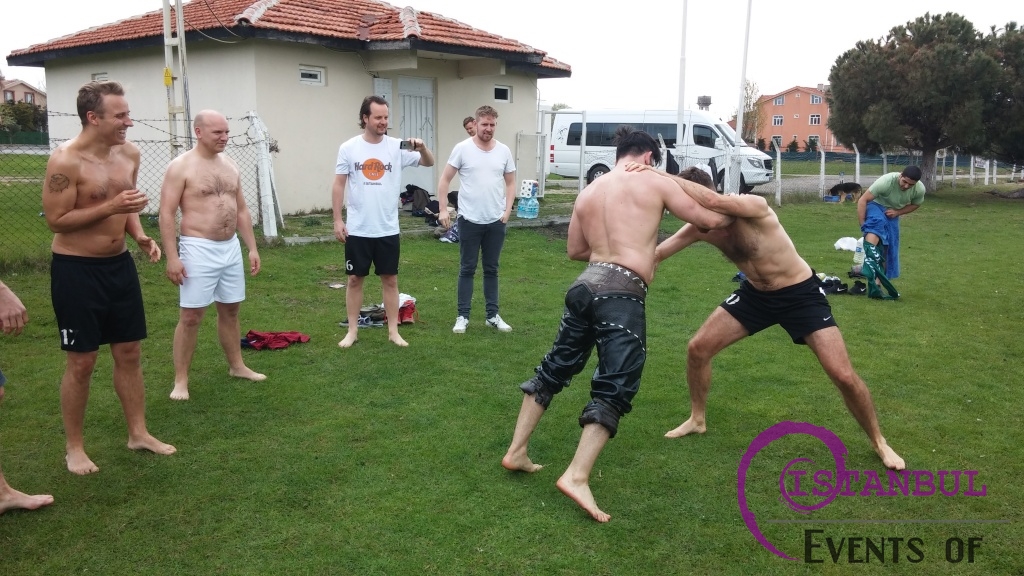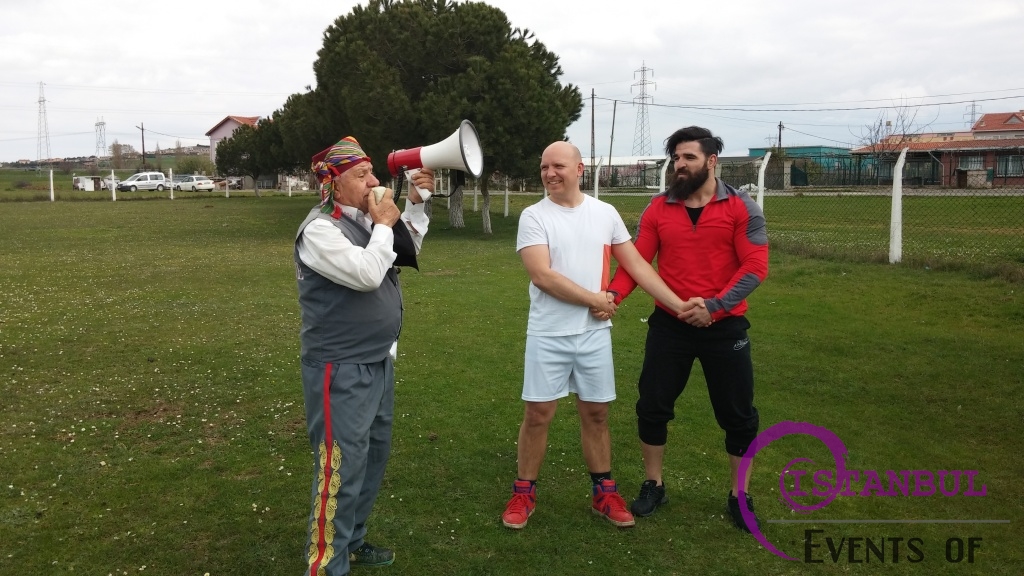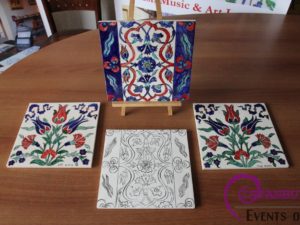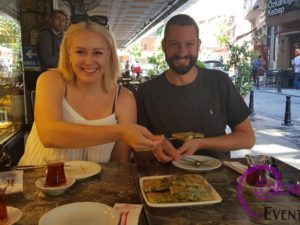Oil Wrestling Training Acitivity Class Outside Istanbul
350,00 EUR
Private Oil Wrestling Workshop outside of Istanbul
reservation.
Description
Oil Wrestling Training Acitivity Class Outside Istanbul
- Duration: Half Day Activity
- Location: Meeting in Sultanahmet or from city center hotels / ISTANBUL
- Tour Language: available in English and Turkish
Overview ;
Turkish Oil Wrestling – Yagli Gures Training in Istanbul. In this training, we will drive to the area outskirts oof istanbul and with our professional wrestler, you will learn the techniques traditional Oil Wrestling in istanbul.
What you will see ;
We will pick you up from your hotel and after that we will drive to our open space oil wrestling field in the outside of Istanbul. ( App. 50 Minute ) We will meet with our trainer, change our clothes and our wrestler will tell us about the history of traditional oil wrestling. Then we will warm up and make 1 hour of workshop together.
Ifter the training, we will change and drive back to istanbul.
What is Included ;
- Pickup and drop for city center hotels.
- Private transfer to Oil Wrestling Field with minivan
- Oil Wrestling Training app for 1, 1.5 Hours
- Sightseeing in the Area
Meeting Point ;
We can pick you up from your hotels or flats ( For city center areas ) or start the tour from our culture center.
Here is our Art Studio Address ;
Google Maps : https://goo.gl/maps/uXuyRmELZsx
Events of Istanbul – Les Arts Turcs Art Studio
Alemdar Mh. Incili Cavus St.
No: 19 Floor : 3 (Behind The Underground Cistern)
Sultanahmet 34110
Istanbul, Turkey
Contact : Mr. Alp or Mr. Nurdogan ( Phone : +90 544 220 10 22 )
E-mail : info@eventsofistanbul.com
Cancellation Policy ;
Here in this link you can find the details about our cancellation policy.
Additional Information ;
Please wear comfortable clothes and shoes. Also bring towels and extra clothes.
The activity will be outside in the grass fields soo good weather required.
History of Turkish Oil Wrestling
This is one of the most popular sports in Turkey. Yagli gures means literally oiled wrestling. The wrestlers wear tight short leather trousers called “Kispet”, made of water buffalo leather weighing approximately 13 kilograms, and they cover themselves with olive oil. Matches take place throughout the country but the most famous and most important tournament takes place in Edirne the end of June and beginning of July, or at the end of July, every year. In 2016 the matches of the 655th edition were held between 18-24 July. The wrestler Mr. Recep Kara won the final match and holds the title of “bas pehlivan” for the 4th time in his career. The 656th edition of the tournament will be held between 10-16 July 2017.
It’s a big fair as well with music and celebrations and it goes on until the morning. Usually lamb roast is a very popular food. In the entertainments, belly dancing is accompanied Turkish traditional musical instruments ‘davul’ (drum) and ‘zurna’ (a type of flute) and singings.
The Kirkpinar (“Forty Springs”) in Edirne, Turkey is the annual world series of Yağlı Gűreş (greasy wrestling), the Turkish national sport. Kirkpinar #639 was held in 2000, making this the oldest continuing sporting event in the world. Almost 1,000 entrants from throughout Turkey compete in a three-day elimination tournament.
turkish-wrestling-rules-and-customsThere are thirteen categories, each with a 1st, 2nd and 3rd place winner:
(1) Baş Pehlivan (chief wrestler), (2) Başaltı (under chief); (3) Bűyűk Orta (big medium), (4) K. Orta Bűyűk Boy (small medium big size), (5) K. Orta Kűçűk Boy (small medium small size); (6) Deste Bűyűk Boy (supporting big size), (7) Deste O. Boy supporting medium size), (8) Deste Kűçűk Boy (supporting small size) ; (9) Toz Koparan (“kickers up of the dust”), (10) Tesvik (“encourager”), (11) Minik-2 (“small and sweet 2”) (12) Minik-1 (“small and sweet 1”), (13) En Iyi Peşrev (best beginner). These divisions are not set weight alone, as in the U.S. and Europe; rather pairs are chosen a kind of judges’ handicapping that considers size, age and “track record.” The sole exception is the top category (Baş Pehlivan), in which match ups are decided a lottery in full view of the stadium crowd. An ancient Moslem adage says that men should be lifelong wrestlers, “from seven to seventy.” The age range at a modern Kirkpinar is approximately from twelve to forty. Day One is devoted entirely to the lower categories; days Two and Three involve all thirteen categories.
At the tournament’s conclusion champions’ medals and purses are awarded, usually the President of Turkey and its political and military leaders. The cost of these is borne the year’s Ağa (Lord), a merchant benefactor who underwrites much of the festival expenses and who presides over the matches in a regal Ottoman-era costume.
Before matches begin the pehlivans (“wrestlers” or “heroes”) oil their bodies with a mixture of olive oil and water so that they can endure the heat of the day in a bout which until modern times was fought without a time limit. Originally embraced as the basic method for conditioning the Sultan’s Janissaries (the “Marines” of the Ottoman armies), oil wrestling is more about strength and endurance than clever moves. Each fighter wears a kispet, sturdy leather trunks from the waist to below the knees. He also wraps coarse cloths around his knees in order to block the opening of the cuffs against his opponent’s probing fingers. There is no headgear, and the inevitable cauliflower ears are worn as badges of manliness. The writing in metal studs on his butt indicates his name or his sponsoring club, usually his home town.
All fighters in a given division line up along one side of the field and are introduced the Cazgır (announcer or master-of-ceremonies). He summons them in Allah’s name to manly valor on the field of battle, as the pairs of opponents join hands. The pipe-and-drum band begins playing and each wrestler starts his peşrev, a symbolic journey into the wilderness, a hero’s quest. He wanders into the field, kneeling for prayer, leaping, working himself up for the ordeal. Four times he meets his opponent, and they exchange symbolic greetings. After the last greeting they shake hands and begin the battle, each pair with its assigned referee. The match is not confined to any one part of the field, and often ranges over a large area with the referee running to keep up. Under modern rules they have approximately 30 minutes to decide a winner. Failing that, the referee pauses the match and sends them off to the judges’ stand. There they re-oil their bodies, wrap identifying ribbons around their ankles, and begin a “sudden death” overtime. The first wrestler to take his opponent down and gain the advantage position is declared the winner. They then embrace, and the winner registers his victory with the clerk. That qualifies him for the next heat in his division against another winner. He seldom has much leisure time to recover.
How a Winner is Decided
The essential pin in Yağlı Gűreş is similar to that in Greco-Roman wrestling (which, incidentally, is neither Greek nor Roman, but a modern European adaptation. Except for covering their nakedness with a kispet – which is an act of male modesty commanded Mohammed – the Turks claim that theirs is closest to the classic Greek style). The first wrestler whose “umbilicus is exposed to heaven” loses the match. Holding of the shoulders to the ground for a period of time is not an element in the pin.
There are alternatives to this basic pin which also constitute a victory:
(1) The “crush.” A fighter may maneuver his opponent onto his stomach and then trap him sprawling on top. If he can keep him down with his face buried in the grass he can then turn his exhausted opponent with a half-nelson for a pin. This is a dangerous move, and the referee monitors closely to see that the bottom man is not suffocated. If the “crusher” is not successful after a given period the referee has them begin again from a standing position.
(2) Submission. Occasionally the match under a hot summer sun is so long and arduous that one fighter will simply signal his submission to the referee. Pin.
(3) Since a wrestler is not restricted from placing his hands inside his opponent’s kispet (he may not grab his balls or invade his rectum, however), he can also use the waistband to hold the other man in place. Occasionally the kispet is yanked so far below his hips that the fighter being held cannot rise without exposing himself. Having lost his trunks he also loses the match.
(4) If a fighter is able to lift his opponent entirely off the ground and carry him five paces in any direction, that is a “carrying” pin.
(5) A running “flip” is sometimes employed, in which the wrestler causes both his opponent and himself to expose their navels during the roll. The loser is the one whose navel is first to be exposed. Unless the initiator of this move is careful, he may find himself the loser even though he was the “flipper.”
The extraordinary (western standards) sportsmanship and mutual respect between Turks is most clearly displayed whenever one gets a bit of grass in his eye or needs to adjust his kispet. Without any particular signal from the referee they simply disengage and correct the situation. If water is needed to wash out an eye it is the opponent who runs to fetch it. If sweat has blinded the eyes of a wrestler they stop long enough for the referee to hand each of them a wad of cheesecloth for wiping. Often winner and loser will walk off the field together arm in arm. If one fighter is injured and a stretcher crew is unavailable it is his opponent who will assist him off the field.
The rules are few in comparison to those governing western styles, relying more on a tradition of comradeship than upon detailed prohibitions. A wrestler may grab his opponent’s kispet in any way which helps him with a throw, or to control or for a pin. Sometime he will thrust his arm down the other’s kispet up to his armpit in order to obtain leverage. Despite this freedom, the intentional fouling of a wrestler is almost unheard of.
Hitting is a little more problematic, and the referee’s discretion is the only real arbiter. Open-handed blows to the back of the opponent’s neck, trying to shove his head down, are common. Usually the opponent will respond with the same blow. Even hitting the face with an open hand is tolerated, although that can lead to impromptu fisticuffs and flared tempers. The referee then halts the action and admonishes both wrestlers before they can continue. On very rare occasions of flagrantly bad sportsmanship the referee will award the match to the victim.
We often receive inquiries about these wrestlers’ conditioning and weight-lifting routines. The fact is that weight rooms and gyms are very rare in Turkey. Their exceptional physiques and world-famous endurance are chiefly the result of constant practice wrestling from a very early age. For centuries wrestling has been their favorite pastime, at home, on picnics, whenever. Turkish public schools do not have extensive sports programs, but there is a wrestling club in practically every community. Only one club that we know of has an indoor year-round facility (in Ankara). The rest troop out into a field near town where there is sufficient grass to soften the impact of being slammed around, and the oğretmen (teacher) and his oğrenci (students) have at it until they can’t see one another in the darkness. There are approximately forty major tournaments in Turkey throughout the year, and clubs will travel hundreds of miles to compete. A wrestler is a highly respected member of his community, although winners’ purses are, western standards, a modest reward for the most physically demanding sport in the world.
Dr. Donald Stewart Miller
Stevenson, Washington, USA.






